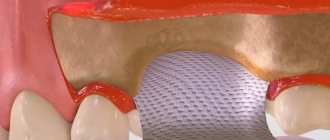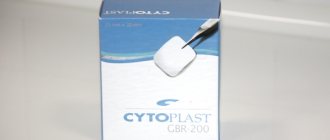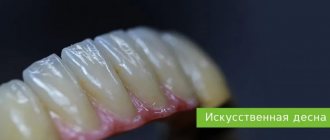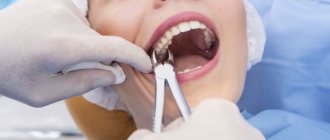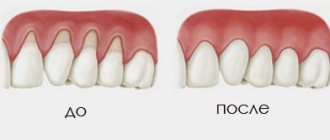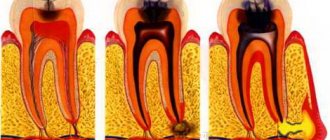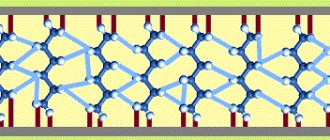Author: Brodsky Sergey Evgenievich Deputy Chief Physician, Candidate of Medical Sciences in the specialties: dentistry and medical microbiology In dentistry, almost all operations to build and restore the jaw bone contain the stage of installing membranes. Most patients who are planning to restore their eubs by installing implants and who learn more about all the stages of the operation are interested in why a membrane is used in bone grafting. Their use is required in case of acute deficiency of jaw bone tissue, if it is necessary to restore large volumes of it. The use of a membrane during implantation can successfully prevent the resorption of bone structures and eliminate bone atrophy, which creates favorable conditions for implantation of implants into it.
What is a dental membrane? Indications for installation
Dental (barrier) membranes are one of the achievements of modern dentistry, which is a thin film that is attached during the implantation procedure to the jaw, an area where bone tissue is actively destroyed. When asked frequently by patients about what bone membranes are made of, experts answer that they are most often made from collagen. The use of a collagen membrane in dentistry can effectively fix bone material, avoid further bone destruction and strengthen mobile teeth. The main indications for installing membranes are:
- a membrane is placed after tooth extraction to prevent bone tissue from shrinking;
- During bone grafting, a membrane is installed to form the missing volume of bone tissue;
- the membrane during sinus lift surgery, installed under the bottom of the maxillary sinus, reduces the risk of osteoplastic material getting into the maxillary sinus.
Types of membranes in dentistry
Today, the use of barrier membranes is the most environmentally friendly and most widely used method of strengthening deteriorating jaw bones. It is used much more often than complex bone grafting. There are several types of dental membranes:
Resorbable (resorbable). These membranes independently dissolve in the jaw tissue, so their further removal is not required. Dentists use 2 types of such membranes:
- synthetic polymers - their advantages are complete hypoallergenicity, no risk of infection transmission and long-lasting action for 5-6 months;
- xenocollagens of animal origin - have very high biocompatibility with jaw tissues.
Non-resorbable (non-absorbable). Dense dental films, which must be removed surgically, since they are not able to dissolve on their own during use. Installation of such membranes is necessary in case of significant destruction of bone tissue. There are also 2 types of them:
- frameless, used for average, up to 4 cm, lack of bone tissue;
- with a titanium frame are used for significant destruction of the jaw bones.
Membranes from the patient's blood plasma are also widely used . The plasma lifting procedure is carried out directly in the dental office and does not require special preparatory measures - the most important thing is to avoid alcohol, spicy and fatty foods on the eve of the procedure. The plasma lifting procedure itself is carried out as follows:
- Blood is taken from the patient’s vein;
- tubes with the resulting biomaterial are placed in a centrifuge for 10-40 minutes, depending on the platelet sedimentation rate of a particular patient;
- A thick clot of plasma is taken from the test tubes - it can be used in various manipulations - cut, sutured, etc.
Ready-made membranes can be stored for no more than 4 hours, so the procedure for their manufacture is carried out directly on the day of surgery.
Stages of membrane installation during implantation
Installation of dental membranes requires the surgeon not only to have operational skills, but also to have high qualifications and extensive experience. The technology of the operation consists of the following stages:
- administration of anesthesia;
- cutting and peeling of the mucous membrane;
- filling the resulting hole with granules of bone material;
- installation of a barrier membrane for bone material granules.
In rare cases (during complex operations), the installed membrane is fixed with special small pins (buttons) and the gums are sutured. If a non-resorbable membrane is sewn in, surgery is repeated after some time to remove it.
Bone membrane: application in the Partner-Med clinic
It cannot be argued that the most important step before dental implantation is the choice of a clinic and a doctor. Today, a huge number of dentists offer this service, but not all of them will provide it with high quality. Dentistry Partner-Med is one of the few Moscow clinics where the patient will undergo this procedure with the highest quality. Our highly qualified specialists, many years of experience and regularly updated levels of professional training have thousands of successfully performed operations behind them.
Our dentists know in practice when to use a membrane when installing an implant, and will immediately determine which one is suitable for a particular patient. The level of professionalism of doctors is confirmed by numerous reviews from patients who are no longer ashamed of their smile.
Our additional advantages are:
- free initial consultation;
- individual selection of treatment;
- reasonable prices for services;
- permanent promotions.
Deputy Chief physician Sergey Evgenievich Brodsky
Sign up for a free consultation
+7
Just CALL US!
+7
We will answer any of your questions and will definitely help you!
Characteristics and purpose
Collagen is a substance that has the ability to completely resorb. Thanks to this characteristic, the product is used in different areas of dentistry.
The membrane performs a protective function and acts as a barrier to the apical entry of epithelial fragments into the organ. The device helps ensure self-reproduction of bone in the area of augmentation.
The participation of soft fragments in bone regeneration is limited.
Upon contact with moisture, the drug changes color and becomes transparent. The dense fibrous structure prevents the entry of gingival fibroblasts and promotes the growth of bone-forming fragments.
The material is durable and has low antigenic parameters.
Fixing elements of different types
The membrane is adjusted to the size of the defect, or the required dimensions are transferred to it using sterile templates in the package. The edges should overlap the boundaries of the bone defect by at least 2-3 mm . Fixation can occur in one of several ways:
- Before installation, the resorbable pad is pierced and placed on the implant using the rubber dam principle. The edges are secured with screws or pins into the bone, in which holes are previously created with burs. Additionally secured with sutures to the periosteum. When used on the upper jaw, titanium pins with a wide head are used for fastening.
- The self-curing mixture or film with an adhesive composition is fixed directly to the alveolar process.
- Non-resorbable plates are fixed with titanium pins or microscrews. The edges of the barrier must be tightly adjacent to the bone to prevent soft tissue ingrowth. When suturing the mucosa, small diameter suture material is used. The thread should pass along the edge of the membrane in contact with the neck of the implant. The stitching is done in the middle of the overlay between the edge stitches.
Opinion of a dentist-implantologist : “The success of implantation depends on how accurately patients follow medical recommendations. The operated area should be protected from hard, hot foods. Hygiene must be regular. Medications are taken only in consultation with a doctor.”
- Complete restoration of the dentition in just 4 days!
more detailsRoott Pterygoid Implants Sinus lift is no longer needed!
more details
Once and for life! Express implantation in 4 days with a permanent ReSmile prosthesis
more details
All-on-4, All-on-6, ReSmile, Zygomatic implantation We use all modern methods of dentition restoration
more details
Indications
The use of the membrane is indicated in clinical situations:
- Damaged walls of bone fragments during incorrect surgical intervention.
- Augmentation of the sinus node base.
- Restoration of the jaw ridge.
- Pathologies of denestration.
- Defects of periodontal fragments.
- Atypical signs of dehiscence.
- Amputation of the apex of the root surface.
- Tooth extraction.
- Bone resections.
- Augmentation.
The main indication for the use of the membrane is immediate or delayed tissue regeneration using a targeted method of exposure.
Contraindications
It is strictly prohibited to use the product if:
- Infectious processes in the oral cavity.
- Contraindications to dental implantology.
- General diagnoses.
- Intolerance to components.
The doctor evaluates potential complications and contraindications at the first appointment.
Advantages
Collagen is recognized as the most compatible material with natural tissues. Not only the material itself, but also its decomposition products are biocompatible.
In the human body, over 60% of the total volume of protein compounds in gum tissue is collagen.
The list of advantages of a collagen membrane is due to the characteristics of the material:
- Minimal manifestation of antigenic properties. The safe transfer of collagen of animal origin into the human body is allowed.
- Active participation in hemostatic processes.
- Chemostatic effect on the state of periodontal cell fragments.
- No inflammatory processes in the area of application.
- Collagen is a natural hemostatic agent.
Minuses
Like any other material, collagen has disadvantages:
- Risk of allergic reactions.
- In rare cases, inflammation of the tissues adjacent to the product may occur.
Despite the fact that the product is adapted to the tissues of the human body, there is always a risk of infectious manifestations progressing to the acute stage.
Application of the product for tissue regeneration purposes
Collagen is able to activate restoration processes in the human body at the cellular level. The low risk of membrane detachment from the walls of the restored area increases the effectiveness of therapy.
Application for bone restoration
Collagen membranes are highly purified natural components. The biocompatibility and matrix structure of the product allows for high-quality restoration of bone fragments.
The product has two sides:
- Smooth. Promotes intensive wound healing.
- Rough. Activates cellular growth of bone.
The product can be used independently or in combination with patient cell material.
The lineup
Large dental brands are engaged in the production of collagen membranes. The list of popular models includes:
- Collprotect. A product with a rough three-dimensional porous surface. Provides controlled healing. Prevents the development of inflammatory processes.
- Jason. An easy-to-use device that ensures accurate results. Attached according to the principle of a multi-vector network.
- Alpha-Bio's GRAFT Collagen Membrane. It has two layers and a wavy structure.
The use of the product in dental practice is designed to simplify the work of dentists and reduce the likelihood of complications.
Membrane exposure after bone grafting - consequences and treatment
The non-resorbable membrane pad is exposed in 1% of cases , causing the following consequences:
- wound infection with the development of purulent inflammation;
- rejection of osteoplastic material during vascularization of the mucous membrane (in 40-50% of cases).
In such situations, it is recommended to remove the implanted materials, carry out treatment, and then repeat bone grafting. Typically, a second layer of soft tissue is formed under the incision using a mucoperiosteal flap. To do this, it is peeled off, split, modeled, and then sutured in layers.
The exposed resorbable pad should be treated with 3% hydrogen peroxide and 0.12% chlorhexidine. Sometimes this allows you to postpone the removal procedure by 8 weeks.
Opinion of a dental surgeon : “Most of my patients are smokers. Many people do not immediately realize the complexity of the situation caused by their bad habit. Smoking causes a sharp narrowing of the blood vessels in the mouth. This weakens the flow of blood filled with oxygen and nutrients. Due to their lack, the healing process is delayed. Therefore, you need to completely stop smoking at least a couple of weeks before implantation and for several months after it.”
Benefits of Collagen Membrane, Genoss
- the minimum period of epithelization in the open state is only 2-3 weeks (!),
- size (thickness 0.3 mm),
- resorbability in 8-10 months,
- rigidity is a guarantee of excellent barrier function and reliable stabilization of bone material,
- ease of use.
The excellent characteristics of the Genoss membrane have already been appreciated by many dentists, so today you can inexpensively buy a Genoss collagen membrane in the Dental Market online store.
The price of the Genoss collagen membrane at Dental Market is more than acceptable, especially considering the real opportunity to receive free consultation from a specialist, assistance in placing an order and fast delivery.
Call Dental Market by phone 8 (495) 118-76-20
.
Online store "Dental Market" - flexible prices, quick help in any situation!
Genoss Collagen Membrane
Genoss multilayer resorbable collagen membrane is made from bovine type I collagen.
Collagen Membrane, Genoss ideally stabilizes bone material, perfectly epithelializes in the open state, therefore it is widely used in all possible operations of directed bone regeneration.
Collagen Membrane GCM1520
Collagen Membrane GCM3040
Collagen Membrane GCM2030
Collagen Membrane GCM1020
Preparation for plasma lifting
To carry out the innovative dental method of plasma lifting at a reasonable price, Implantmaster in Moscow has all the necessary latest equipment. Before carrying out medical manipulations, a thorough visual and instrumental examination of the oral cavity is carried out at the consultation. Next, the specialist will order an x-ray.
We perform cone beam computed tomography. The pictures are more accurate, and the Rg radiation is even less. Thanks to this, the most accurate diagnosis can be made.
Our doctors use a Labomed Magna dental microscope to thoroughly examine the condition of teeth and surrounding tissues. An examination is also carried out to determine contraindications to surgery. If no contraindications are identified, then a treatment plan is drawn up.
The doctor answers all the patient’s questions. He explains in detail the surgical procedure and schedules an appointment. To undergo the procedure as comfortably and correctly as possible, you should perform preparatory measures before performing plasma lifting:
- pre-carry out professional cleaning of the oral cavity;
- 7 days before the procedure you should not drink alcohol, heavy and spice-rich foods, or hot drinks;
- minimize smoking;
- increase the amount of water consumption to 2 liters per day;
- before treatment, do not take painkillers and drugs that affect blood clotting;
- Do not eat before the procedure.
These recommendations will allow you to carry out the upcoming procedure most effectively. And after the operation, you must follow all the specialist’s instructions.
Types of dental membranes
Types of dental membranes are divided into two groups - resorbable and non-resorbable.
Non-resorbable membranes must be removed at the end of treatment, as they do not resorb. And repeated surgical intervention, which is obvious, always means repeated trauma and, as a consequence, an increased period of tissue restoration until complete healing, the risk of possible complications and inflammatory reactions, increased time and cost of dental treatment.
Resorbable membranes do not need to be removed. They completely dissolve. Accordingly, the risk of tissue trauma and treatment time are significantly reduced, the regeneration process is accelerated, and therefore the overall recovery time for the patient and the cost of dental treatment.
What is platelet fibrin
Human blood contains formed elements, one of which is transparent, anucleate cells - platelets. They take part in the process of blood clotting and stopping bleeding. During the destruction of the walls of a blood vessel, platelets, disintegrating, release components that form blood clots. In the 80s, an effective function was discovered: to increase the rate of healing and tissue restoration. This process occurs due to the release of growth factors (hormonal components) that enhance the regeneration of old cells, as well as the growth and increase in the number of new cells.
Platelet autoplasma is not only formed elements, but also saturated platelet fibrin. This is a yellowish liquid released when blood is processed in a special centrifuge.
It contains:
- platelets;
- fibrin;
- fats;
- hormones;
- nucleic acids;
- mineral components.
After the autoplasma is introduced into the jaw bone, growth factors are activated within a week. The tissues are intensively saturated with oxygen, and a dense capillary network is formed. The rate of restoration of jaw bone cells and their growth, as well as tissue nutrition, increases.
Human autoplasma is saturated with nutrients and is biocompatible with the body, because it is its own product. Consequently, engraftment is successful and side effects never develop. The restoration is proceeding as planned.
Recommendations after plasma lifting
Plasmolifting is carried out in combination with other medical procedures. The duration of the rehabilitation period is determined depending on the disease and the medical procedures performed.
Recommendations for the patient to follow after treatment:
- limit physical activity during the recovery period;
- avoid exposure to high and low temperatures - baths, saunas, solariums;
- do not disturb the intervention site with your tongue and brush;
- maintain proper oral hygiene;
- temporarily eliminate hard and irritating foods and alcohol consumption.
